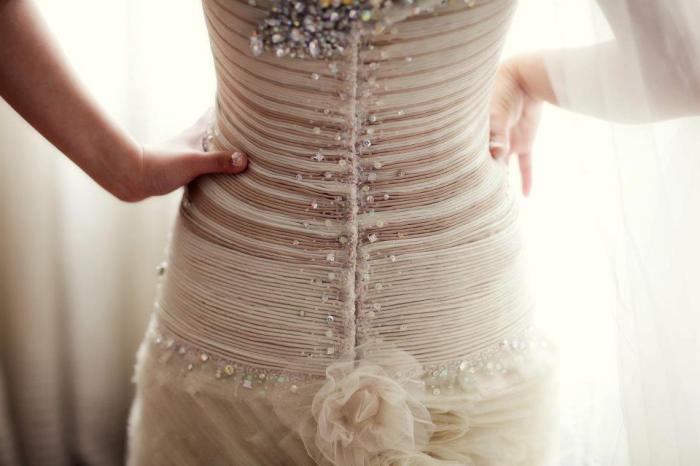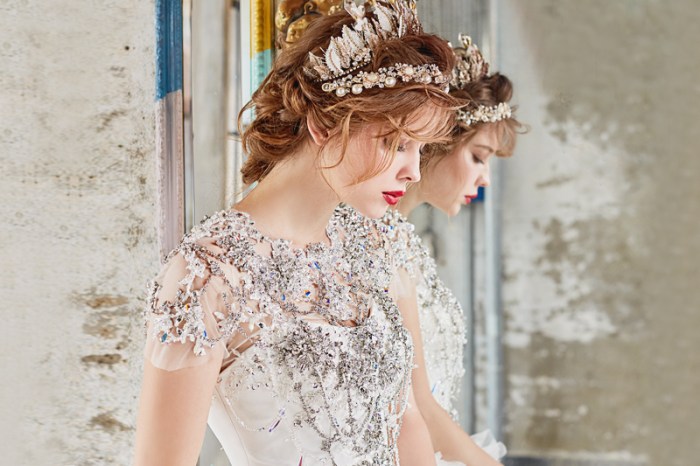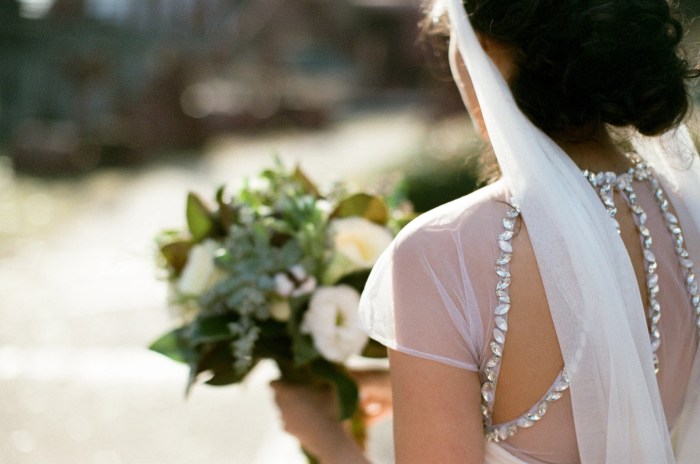Back Beaded Wedding Dresses: A Detailed Exploration
Back beaded wedding dresses offer a captivating blend of elegance and intricate detail, transforming a classic bridal look into a statement of personalized style. This exploration delves into the design, construction, and care of these stunning gowns, providing insights for brides and designers alike.
Defining Back Beaded Wedding Dresses

Source: onewed.com
Back beaded wedding dresses are characterized by elaborate beadwork adorning the back of the gown, often extending from the neckline to the hem or focusing on a specific area. This intricate detailing adds texture, shimmer, and a touch of glamour. The level of detail can vary significantly, from subtle accents to densely packed beading that creates a three-dimensional effect.
Various beading techniques are employed, including hand-beading for intricate designs and machine beading for larger areas of coverage. Beads themselves range from delicate seed beads to larger crystals, pearls, and sequins. The style of back detailing also influences the overall look, with common choices including V-neck, scoop back, illusion back, and low backs, each offering unique opportunities for showcasing the beadwork.
- Beading Techniques: Hand-beading allows for precise placement and complex patterns, while machine beading offers speed and consistency for large-scale designs. Some gowns even combine both techniques.
- Bead Types: Crystals offer brilliance and sparkle, pearls add a classic elegance, and sequins provide a more modern, playful shimmer. Mixing bead types can create a layered effect.
- Back Detailing Styles: A V-neck back allows for a dramatic display of beading, a scoop back provides a more modest yet elegant approach, while an illusion back creates a sheer, ethereal effect with beading strategically placed for coverage.
Design Elements and Aesthetics
The placement and density of beading significantly impact the overall aesthetic. Sparse beading can create a delicate, understated look, while dense beading creates a more opulent, dramatic effect. The choice of beading pattern also influences the visual impact; geometric patterns offer a modern feel, while floral or abstract designs provide a more romantic touch.
Back beaded wedding dresses offer exquisite detail and timeless elegance. For brides seeking a similar level of luxurious craftsmanship, exploring the designs of amanda wakeley wedding dresses might be worthwhile; their attention to detail often mirrors the intricate beauty found in back beading. Ultimately, the choice depends on personal style, but both options represent high-end bridal fashion.
Different beading patterns create distinct visual effects. For instance, a linear pattern can elongate the back, while a circular pattern can draw the eye to a specific point. Using varying bead sizes and colors adds depth and complexity.
- Pattern 1 (Modern Geometric): A grid pattern of clear crystals on a white silk gown, creating a clean, contemporary aesthetic.
- Pattern 2 (Romantic Floral): Delicate pearl and silver beading arranged in a flowing floral design on a blush-colored tulle gown.
- Pattern 3 (Bohemian Chic): A mix of turquoise, gold, and ivory beads in a free-flowing, asymmetrical pattern on a champagne-colored lace gown.
| Bead Material | Visual Weight | Formality | Example |
|---|---|---|---|
| Crystals | High | Formal | Sparkling, eye-catching |
| Pearls | Medium | Classic | Elegant, timeless |
| Sequins | Low | Modern | Playful, shimmering |
| Seed Beads | Low to Medium | Versatile | Intricate detail |
Materials and Construction

Source: praisewedding.com
Common fabrics used with back beading include silk, tulle, lace, and satin. The choice of fabric influences both the drape and the overall aesthetic of the dress. The beading attachment method depends on the fabric type; hand-sewing is often preferred for delicate fabrics, while machine sewing can be used for sturdier materials.
Secure bead attachment is crucial for longevity. Using high-quality thread and employing techniques like beading over a lining or using beading glue in conjunction with stitching enhances durability. Potential challenges include bead loss during wear, uneven bead placement, and fabric damage during the beading process.
- Fabric Selection: Silk offers a luxurious drape, tulle adds lightness and volume, lace provides intricate texture, and satin provides a sleek, polished look.
- Attachment Techniques: Hand-sewing allows for precise placement and secure attachment, while machine sewing is faster but may require more care to prevent fabric damage.
- Challenges: Bead loss can be minimized through proper stitching and careful handling. Uneven bead placement can be avoided through meticulous planning and execution. Fabric damage can be mitigated by using appropriate needles and techniques.
Wedding Dress Styles and Beading
Back beading complements various wedding dress silhouettes. On an A-line gown, it adds subtle sparkle; on a mermaid gown, it accentuates the figure; and on a ballgown, it provides a touch of elegance to a voluminous skirt. The beading can either enhance or detract from different necklines and sleeve styles; strategically placed beading can draw attention to a beautiful neckline, while excessive beading near a delicate sleeve might overwhelm the overall design.
A beach wedding dress featuring back beading might incorporate natural-toned beads like shells or pearls, arranged in a free-flowing pattern on a light, flowing fabric such as chiffon. The beading would be subtle yet elegant, complementing the relaxed atmosphere of the setting. Modern wedding dresses often feature geometric or abstract beading patterns, while classic dresses tend towards more traditional designs like floral motifs or delicate pearl embellishments.
Imagine a beach wedding dress: a flowing chiffon gown in a soft ivory hue, adorned with delicate pearl and shell beading cascading down the back in a loose, organic pattern. The beading is not densely packed but rather subtly scattered, creating a sense of effortless elegance. The low back allows the beadwork to be fully showcased, complementing the relaxed, romantic atmosphere of the beach setting.
Care and Maintenance

Source: xogrp.com
Cleaning and preserving a back beaded wedding dress requires specialized care. Dry cleaning is generally recommended to prevent damage to the beads and fabric. Avoid harsh chemicals or abrasive materials. Proper storage involves using a garment bag, acid-free tissue paper, and a cool, dry environment to prevent bead loss, discoloration, and fabric damage.
Risks during cleaning or storage include bead loss, fabric damage, and discoloration. Careful handling during transport is crucial to prevent accidental damage. A protective garment bag and a sturdy hanger are essential for transport and storage.
- Dry Cleaning: Choose a reputable dry cleaner experienced in handling delicate beaded garments.
- Storage: Use a breathable garment bag, acid-free tissue paper to prevent yellowing, and store in a cool, dark, and dry place.
- Transport: Use a sturdy garment bag and hanger to prevent damage during transport.
- Long-Term Storage: Consider professional preservation services for long-term storage to maintain the gown’s condition.
FAQ Summary
How much does a back beaded wedding dress typically cost?
The cost varies greatly depending on the bead type, amount of beading, fabric, and designer. Expect a significant price increase compared to a non-beaded dress.
Can I add beading to an existing wedding dress?
Yes, but it requires a skilled seamstress or alterations specialist. The cost and feasibility depend on the dress fabric and desired beading design.
How do I choose the right beading for my body type?
Consider your body shape and the overall silhouette of the dress. Strategic bead placement can enhance certain features and minimize others.
Are there any limitations on the type of beading for a certain wedding theme?
While there are no strict limitations, the beading style should generally complement the overall wedding theme. For example, rustic themes may suit more natural-looking beads, while glamorous themes may call for crystals.

